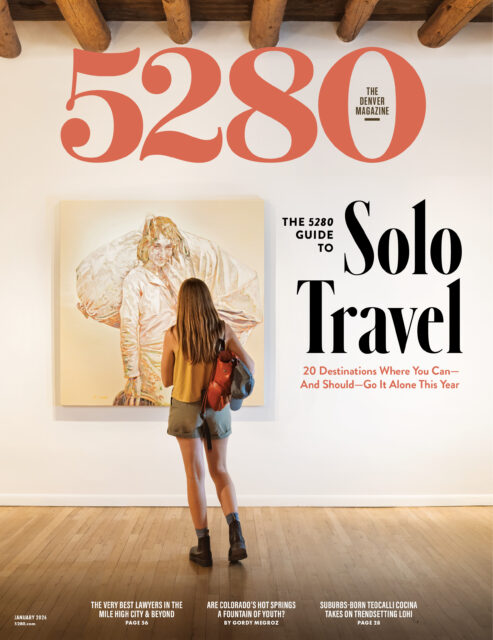The Local newsletter is your free, daily guide to life in Colorado. For locals, by locals.
“I want people to either love my art or hate it, I don’t want them to be complacent.” It’s not that Gregg Deal is trying to be controversial—he wants people to think, and in his opinion, that’s increasingly rare these days.
Deal, 45, lives just east of Colorado Springs with his wife and five children. He’s an artist, an activist, and a member of the Pyramid Lake Paiute tribe. “I’m a professional disrupter,” Deal says, meaning he wants to prevent things—systems, institutions, ways of thinking—from continuing as usual.

Deal’s drive to create has been with him since he was a child growing up in Park City, Utah. “I used to do graffiti in my free time, before and after school,” he says. His love of art led him to George Mason University, where he studied painting, graphic design, and filmmaking. Five years ago, he moved from Washington D.C. to Colorado for an artist residency at the Denver Art Museum. He’s been coloring the state with his work ever since.
While Deal considers himself to be mainly a painter—he recently finished a mural behind the Boulder Theater, as part of the Street Wise Boulder Mural Festival—he’s perhaps best known for his performance work, which tackles stereotypes, conceptions, and misconceptions about Native people. Deal says most Americans don’t know the names of Native leaders, or even the names of the tribes who inhabited the land they now live on. “There are over 570 tribes in the United States that are federally recognized, and even more that are not recognized,” Deal says. There are also over 300 languages, and wildly diverse cultures and customs among these tribes. Deal’s art is the depiction of Native people and life as a Native person—not informed by what Western culture thinks Native art should look like.
Recently, as part of his installation “Modern Indigenous Living” at the Art Students League of Denver, Deal cut off his long braids in front of an audience of about 35 people with Black Flag’s “Nervous Breakdown” playing. The performance had a dual purpose. First, it referenced boarding schools, which started in the United States in 1879 as places of forced assimilation for Native people, where they were made to cut their hair and abandon their tribes’ traditions. Deal’s performance also spoke to the concept of value—of fitting into (or not fitting into) a prescribed version of what a Native person looks like. And for Deal, the performance was also personal. “The cutting of the hair also, for me, symbolized letting some things go as I move onto my next projects,” he says.
“Modern Indigenous Living” has several pieces of social commentary attached to it. “I first came up with the concept in 2014, and then I had the opportunity to put it together in 2016 when I was approached by the Smithsonian,” Deal says. The original version of the piece involved a tipi filled with IKEA furniture—items so commonplace in Western culture. Deal wanted to make stark the disconnect that many Americans have with Indigenous people living the same kinds of lives as everyone else in the U.S. But soon, Deal’s project was stalled. “We were moving forward with the project when the upper echelon at the Smithsonian basically censored the work,” Deal says. He adjusted the piece into something that fit what the Smithsonian was looking for, but Deal says this was another example of how others dictate what being Native means, and what Indigenous art should be.

Ama Mills-Robertson, then program director at the Art Students League of Denver, heard Deal tell this story when he was a visiting artist and teacher. The League spent two years raising the funding for him to put together this work the way he originally intended. The installation—a tipi covered in graffiti, all done by Indigenous artists, and filled with all kinds of artifacts—is currently on display at the Art Student League of Denver campus in the Speer neighborhood, and is accessible on the weekends until October 31.
Deal says it’s great to finally see the project come to fruition. “It’s a bit overwhelming to be able to do it after so long,” he says. “It’s hard too, because it’s in the midst of COVID-19, and so changes have been made involving how many people can observe and participate at once. But everyone has been fantastic in making it happen.”
Next, Deal is working on a music-themed spoken-word performance piece called “The Punk Pan-Indian Romantic Comedy.” Deal says it’s a nod toward Native futurism, identity, stereotypes, and social issues, and is being created through a grant from Arts in Society. It will be completed in June 2021.
Whether it’s a performance work, a mural, or a piece of spoken-word, Deal hopes to be a constant reminder that Indigenous people were on the land known as the United States long before Europeans, and they’re still here, and most importantly, that they matter—they have value.











